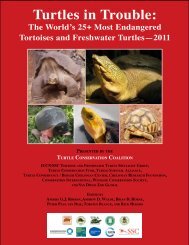WCS Annual Report 2012 - Wildlife Conservation Society
WCS Annual Report 2012 - Wildlife Conservation Society
WCS Annual Report 2012 - Wildlife Conservation Society
You also want an ePaper? Increase the reach of your titles
YUMPU automatically turns print PDFs into web optimized ePapers that Google loves.
Whenever possible,<br />
we try to conduct studies<br />
that benefit both our<br />
park animals and their<br />
counterparts in the wild.<br />
What is the most important function of<br />
zoos today?<br />
Zoos must educate people about wildlife. Our<br />
visitors should learn not only about the biology<br />
and behavior of the species they see, but also<br />
about the threats they face and what can be<br />
done to ameliorate those threats. Zoos should<br />
also inspire visitors to care about nature, and<br />
encourage them to help protect wildlife.<br />
How do the curators at <strong>WCS</strong>’s New York<br />
City parks work together?<br />
We have a diverse, talented, and expert staff that<br />
works cooperatively across our five parks, meeting<br />
twice weekly to discuss issues related to our<br />
animals. <strong>WCS</strong> also has a unified collection plan<br />
that provides key data on more than 1,250 species<br />
– including censuses, population targets, and<br />
future goals – and identifies the role each species<br />
plays in our parks. This unified plan enables our<br />
individual parks to manage their collections at<br />
a facility level, while allowing for the integrated<br />
management of species across our four zoos<br />
and aquarium.<br />
What keeps you passionate about<br />
your work?<br />
I’ve been with <strong>WCS</strong> for over 33 years, and I can<br />
think of no better place to work than the Bronx<br />
Zoo. Part of what makes my job so appealing<br />
is the unlimited opportunity to learn. We have<br />
such a large and diverse animal collection, and<br />
our staff has great expertise in a wide range of<br />
fields. You are constantly exposed to new and<br />
different experiences.<br />
What events stood out for you at the<br />
Bronx Zoo in <strong>2012</strong>?<br />
One was the reintroduction of Kihansi spray toads,<br />
a species declared extinct in the wild, to their native<br />
habitat in Tanzania. The Bronx Zoo played a<br />
major role in saving the Kihansi toad. Our herpetology<br />
department labored for the past 10 years<br />
to perfect this species’ propagation. Working<br />
with the Toledo Zoo, we were able to breed<br />
enough toads to send back to the Kihansi Gorge.<br />
Another <strong>2012</strong> highlight was the first successful<br />
birth of a calf with pure American bison genes<br />
through embryo transfer. <strong>WCS</strong> has a long history<br />
in conserving American bison, and is now focused<br />
on its ecological restoration. Because so many<br />
bison have interbred with cattle, we are looking<br />
to create herds of pure-bred American bison<br />
at the Bronx and Queens Zoos by rescuing<br />
embryos from pure bison and implanting them<br />
in surrogate cow bison, which then give birth to<br />
American bison calves.<br />
What inspired you to go into the<br />
conservation field?<br />
I’ve been fascinated with wild animals for as<br />
long as I can remember. When I was 11 years<br />
old I read an article by George Schaller [then<br />
a field biologist for the New York Zoological<br />
<strong>Society</strong>, as <strong>WCS</strong> was previously known] in<br />
National Geographic highlighting his work<br />
with African lions. From that moment on, I<br />
knew I wanted to work with wildlife. When<br />
<strong>WCS</strong> hired me in 1979, I was thrilled to be<br />
working at the wonderful Bronx Zoo and to<br />
be part of the same conservation organization<br />
as my childhood idol. I can still remember the<br />
thrill I felt when l received a phone call from<br />
George asking me a question about a snow<br />
leopard - it was like receiving a call from<br />
Bruce Springsteen!<br />
What is your proudest achievement?<br />
I’m so proud to be a member of the <strong>WCS</strong> team<br />
of curators, managers, animal care staff, and<br />
veterinarians. This incredible team continuously<br />
tries to advance the high quality care we provide<br />
to our animals, conducts studies to expand our<br />
knowledge in order to benefit our animals and<br />
their wild cousins, and provides opportunities to<br />
train the next generation of zoo professionals.<br />
[ opposite ] Pat Thomas<br />
with a bison herd in<br />
Genesee Park, Colorado.<br />
[ above ] Snow leopard<br />
Leo thrives at the Bronx<br />
Zoo after his arrival from<br />
Pakistan as an orphaned<br />
cub in 2006.<br />
79<br />
Q&A: Pat thomas







![RaLand / SeaScape [PDF] - Wildlife Conservation Society](https://img.yumpu.com/49974326/1/190x245/raland-seascape-pdf-wildlife-conservation-society.jpg?quality=85)









